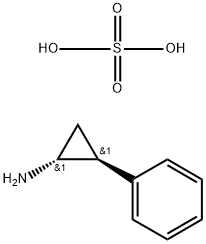13492-01-8
 13492-01-8 結(jié)構(gòu)式
13492-01-8 結(jié)構(gòu)式
基本信息
硫酸反苯環(huán)丙胺 標準品
反-2-苯基環(huán)丙基胺半硫酸鹽
反式-2-苯基環(huán)丙胺 半硫酸鹽
TRANYLCYPROMINE硫酸鹽
tranylcyprominesulfate
tranylcyprominesulphate
phenylcycloprominesulfate
TRANYLCYPROMINE HEMISULFATE
Tranylcypromine Sulfate (125 mg)
TRANYLCYPROMINE HEMISULFATE SALT
Tranylcypromine Sulfate (1672905)
1-amino-2-phenylcyclopropanesulfate
trans,d,l-2-phenylcyclopropylaminesulfate
物理化學(xué)性質(zhì)
安全數(shù)據(jù)
常見問題列表
Tranylcypromine (10 nM to 10 μM) exerts neuroprotective effects against toxicity induced by human Aβ(1-42) oligomers independently from the presence of glial cells. Tranylcypromine (100 μM) significantly protects RGCs from glutamate neurotoxicity-induced apoptosis as well as apoptosis induced by oxidative stress. Tranylcypromine promotes mitogen-activated protein kinase 12 (p38 MAPKγ) expression under conditions of glutamate (Glu)-induced stress. Besides, tranylcypromine contributes to RGC survival via alterations of p38 MAPKγ activity.
Tranylcypromine treatment significantly and substantially reduces the lesion size and improves generalized hyperalgesia in a dose-dependent fashion in mice with induced endometriosis. In addition, tranylcypromine treatment results in reduced immunoreactivity to biomarkers of proliferation, angiogenesis, and H3K4 methylation, leading to arrested EMT and lesion growth. Tranylcypromine (500 mM) injection exerts neuroprotective effects within intracellular apoptotic signaling pathways and suppresses morphologic changes in the retina of the rat, suppresses caspase 3 activity and recovers p38 MAPKγ expression in the retina after NMDA-induced injury, and enhances RGC survival after retinal injury via the attenuation of NMDA neurotoxicity. Tranylcypromine (10 μg/g) causes an approximate and significant doubling of labeled cells in the combined brain regions examined, as detected by BrdU immunohistochemistry. Tranylcypromine causes the greatest increase in cell proliferation in the cerebellum.

